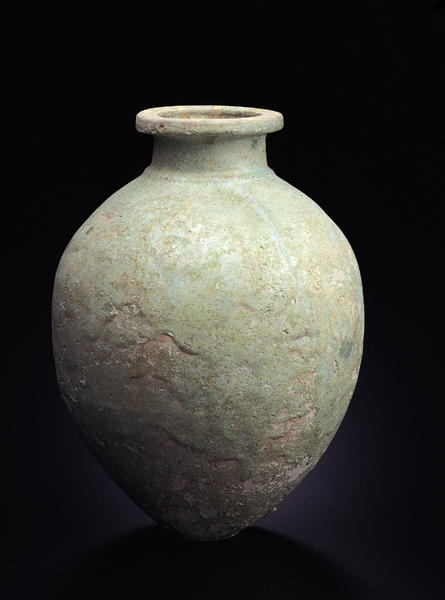施釉壺
- イラク東北部付近
- 新アッシリア
- 8-7 cB.C.
- 陶器
- H-38.8 D-18
焼成、釉薬
この壺は、発色剤の釉薬を厚く塗ったため焼成中にその一部がガラスに変化し、その結果緑色がかった表面を呈するにようになった。釉薬の一部は口縁内にも流れこんでいる。口縁には八本の線が赤褐色の釉薬によって平行に引かれているが、その釉薬は口縁内にまで達している。
Catalogue Entry
This is a complete bottle with a rolled rim on a short neck.1 The ovular body sits on a shallow ring base. A slight ridge ("collar") covers the juncture between the bottom of the neck and the wall of the vessel. The bottle was dipped in a thick, pigmented glaze, which partly vitrified in the firing process, producing several different greenish hues. Some of the glaze dripped into the vessel's mouth.2 Eight equidistantly spaced lines of yellow-red glaze radiate out over the top of the rim and also dripped into the bottle's mouth. The surface is chipped and eroded, with areas of spalled glaze and some losses, but the preservation is otherwise good.
Seven shards from glazed vessels (some may be vessels used in the glazing process) and most of the lower part of a glazed polychrome jar were excavated at Khirbet Qasrij, near the bank of the Tigris, in the Eski Mosul district of northeastern Iraq.3 The principal find was a pottery kiln with associated pavements used in the preparation of vessels for firing and for postfiring activities. The polychrome jar was discovered east of the kiln, beneath the surface but not on a datable pavement.4 Since at least one of glazed shards was identified as a possible waster, and petrographic analysis of three of the shards (one of which was the waster) suggest that the clay is local, it is possible that glazed pottery was manufactured at the site.5 Also, according to the published descriptions, the polychrome jar from Khirbet Qasrij, as preserved, is similar to the Shumei bottle in shape and manufacture.6 Though not found in a well-dated context, the Qasrij example can be compared with other excavated glazed vessels from Ashur and Nimrud. The Ashur examples can be dated only approximately in the eighth-seventh century B.C., or perhaps some even later, based upon the collective date of the bulk of Ashur's Neo-Assyrian graves beneath private houses. The Nimrud examples are late Assyrian.7
A close parallel to our vessel, also dated eighth-seventh centuries B.C. and also undecorated, was excavated at Khorsabad.8 It was mentioned by Muscarella in the publication of a polychrome glazed vessel with a similar shape in the Metropolitan Museum of Art, attributed (but not by him) to Ziwiyeh,9 and also in the discussion of Khirbet Qasrij.10
There are polychrome glazed jars with no sure provenance , but the only excavated parallels come from Assyrian sites; therefore, this type of bottle was probably made in northern Mesopotamia.
SMP
1. Thermoluminesence analysis of samples from the base and spur mark by D. Stoneham, Research Laboratory for Archaeology and the History of Art, Oxford, suggest that the bottle is not a modern forgery. The tests yielded an estimated date of between 1,800 and 2,800 years ago for the vessel's last firing. An actual date is suggested by other considerations described here.
2. In the Ancient Near East such a color normally comes from copper oxide. For the types of glazes available in Mesopotamia see Wulff 1966, pp. 139-40 (thanks to Maude de Schauensee for reminding me of this source). The colors of the glaze on the body of this bottle are grayish-green (Gley varying 8/1-5Gy, 10GY, 5G); the color of the radiating lines is yellow-red, (10 YR-8/4); the color of the clay body is Gley 8/N. Thanks to Mr. Hajime Inagaki for obtaining the Munsell color readings directly from the vessel.
3. Curtis 1989, pp. 44-45.
4. Ibid., p. 23.
5. Ibid., p. 73-74.
6. Ibid., p. 44, pl. XIb, KQ24, no. 351.
7. Ashur: Andrae 1925, pl. 20; Andrae 1938/1977, pp. 184-86; Haller 1954, pl. 3 c?,d; Nimrud: Curtis 1989, pp. 50-51, for the discussion and references. Curtis calls attention to one of three small, glazed polychrome jars discovered in a Neo-Assyrian tomb 54 at Ashur. See Haller 1954, p. 14, pl. 3aw. Another similar jar was found in the burial of Ashur-taklak (Gruft 30), perhaps the eponymous official of the year 805 B.C. If so, this vessel could be dated to the late ninth-early eighth century B.C. See Haller 1954, pp. 109-110, pl. 3as; Andrae 1938/1977, pp. 184-86. This may be the only closely dated polychrome jar in the Ashur repertory. Two of these small polychrome glazed jars from Ashur were republished by Curtis and Reade 1955, p. 157, nos. 141 and 142 (which must be Haller 1954, pls. 3aw and 3at, respectively). These small vessels (about 9-11 cms in height) are the same type as a monochrome example published by Terrace and attributed, probably erroneously, to Ziwiyeh (see the below, n.9).
8. Loud and Altman 1938, pl. 63, no. 231. Noted also by Curtis 1989, p. 51. This vessel seems to be basically monochrome.
9. The unexcavated site of Ziwiyeh cannot be proved as the source for much material attributed to it, which a generation ago might have been suggested as a possible source for the Shumei bottle: see Muscarella 1977, especially pp. 213-17. This would therefore include not only the Metropolitan Museum example (Metropolitan Museum of Art 1983, [Muscarella], p. 71, no. 82) but also those published by Terrace 1966, nos. 49-50, and even no. 51, which is typically Ashur in shape, size, and color. Porada's claim that shards of glazed pottery were found at Ziwiyeh on survey with Dyson (Porada 1965, p. 130, and n.14 with reference to this survey) cannot be verified. None were published by Dyson. Thanks to Oscar W. Muscarella for explaining the pitfalls of the Ziwiyeh.
10. See Curtis 1989.
